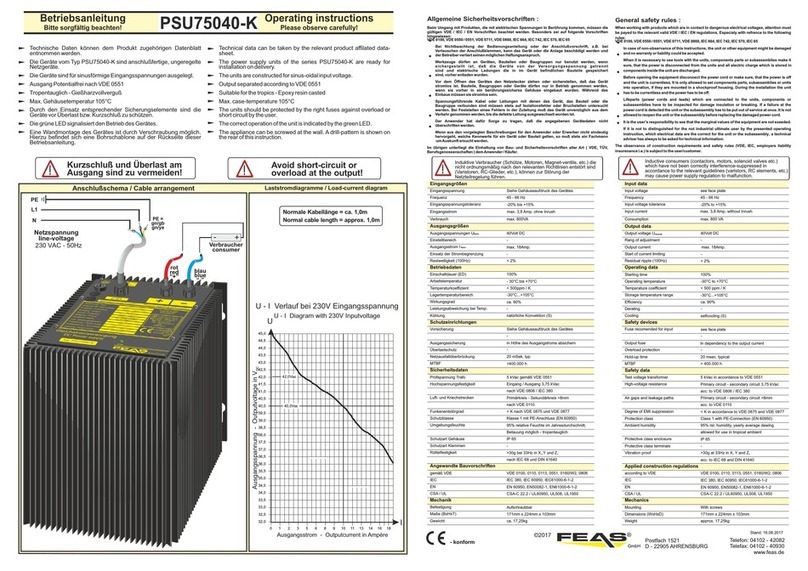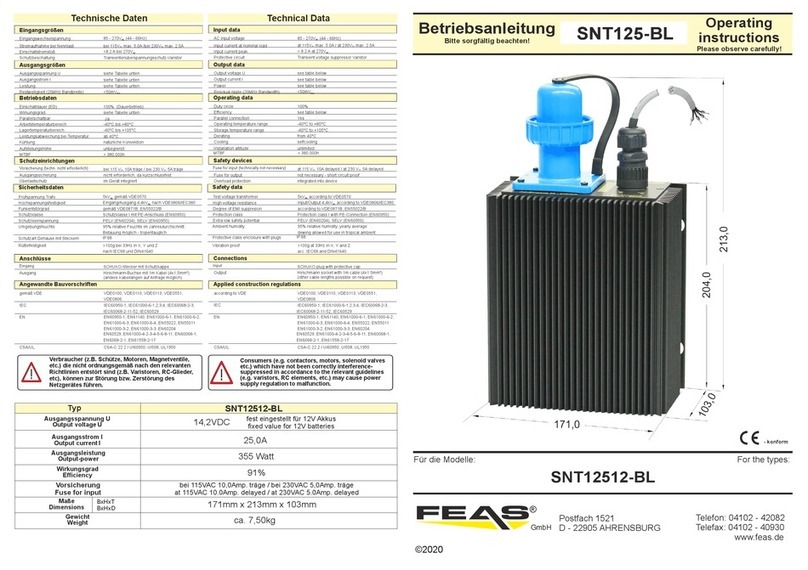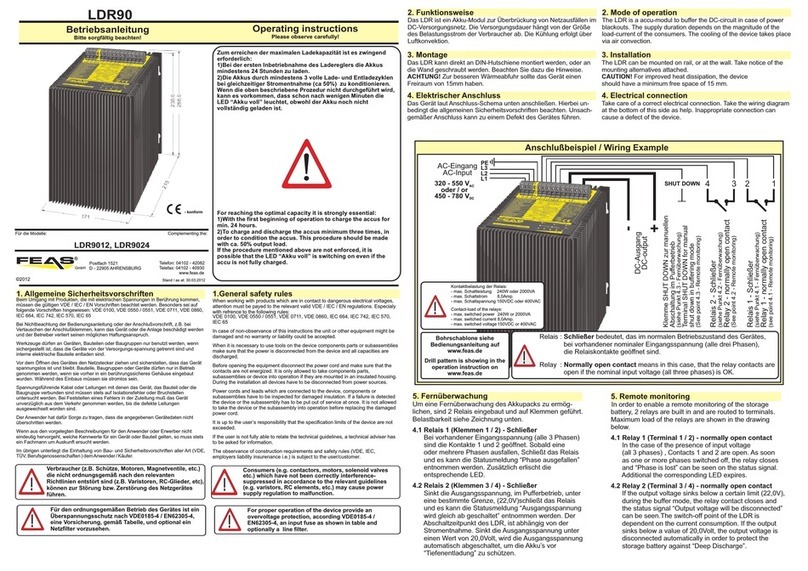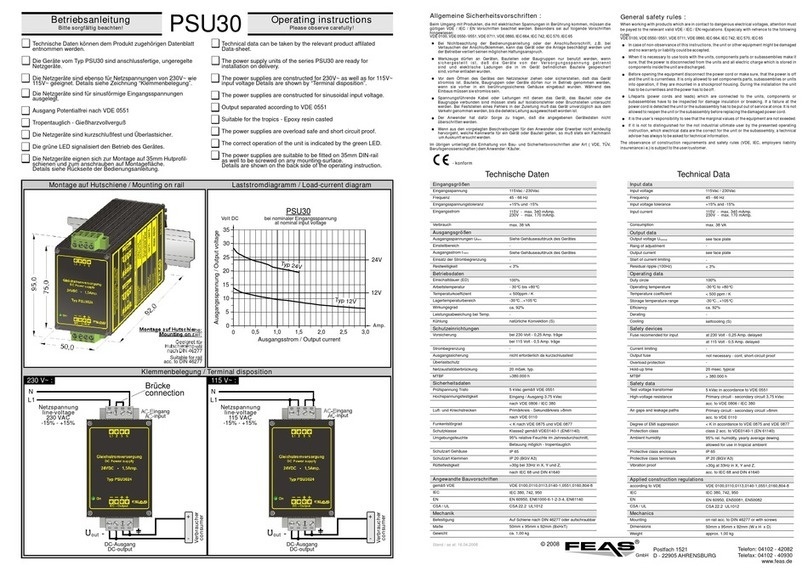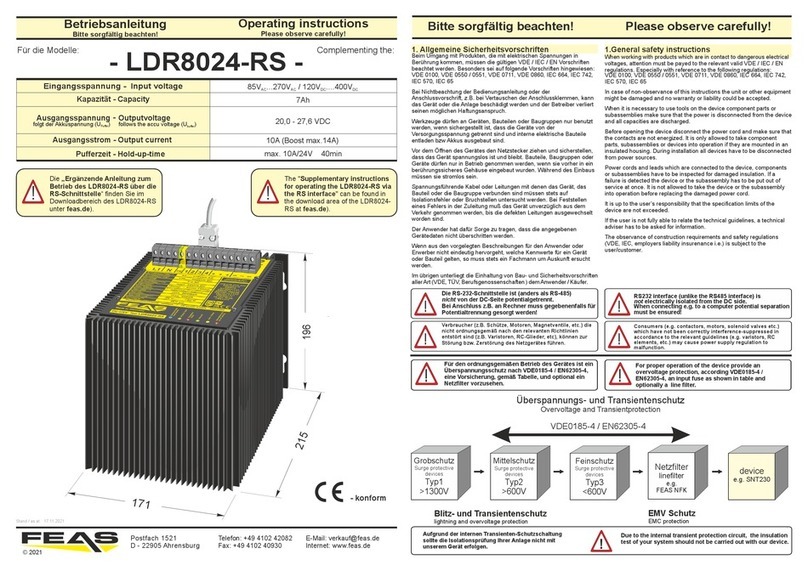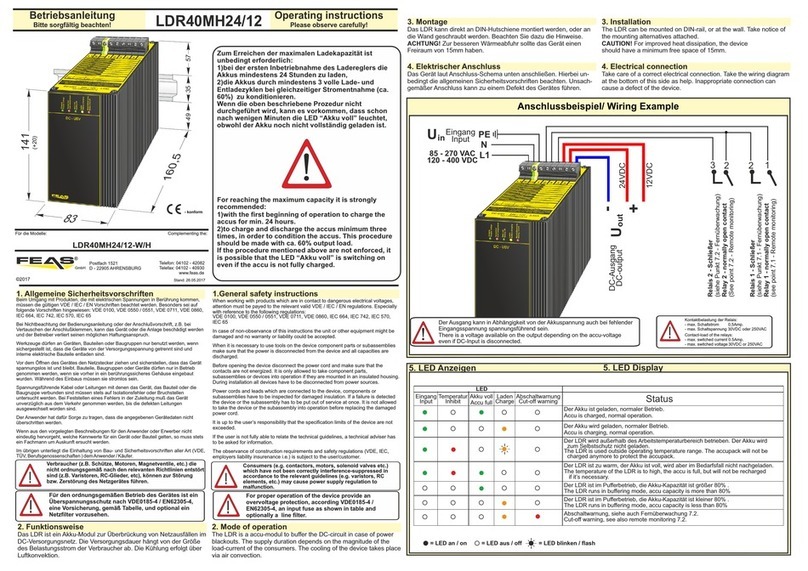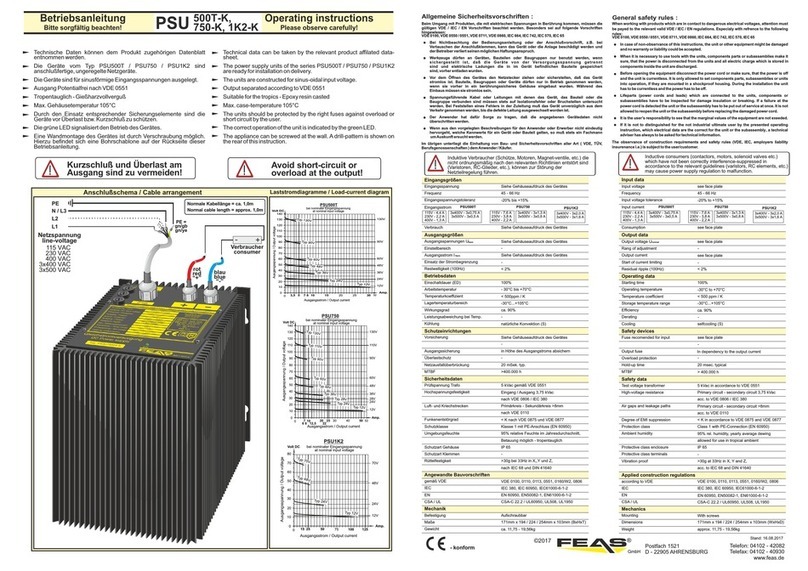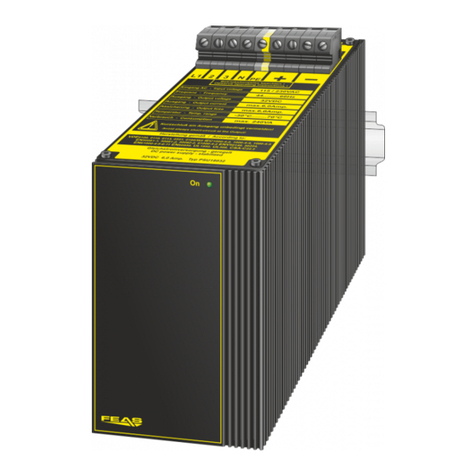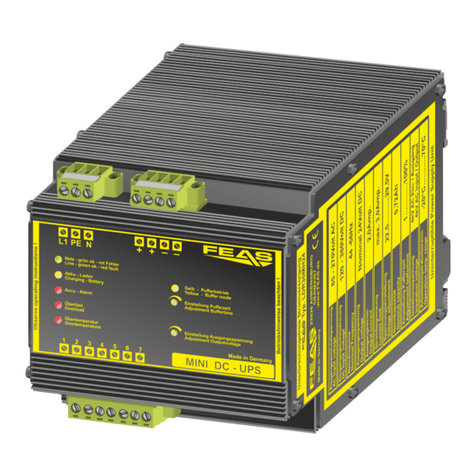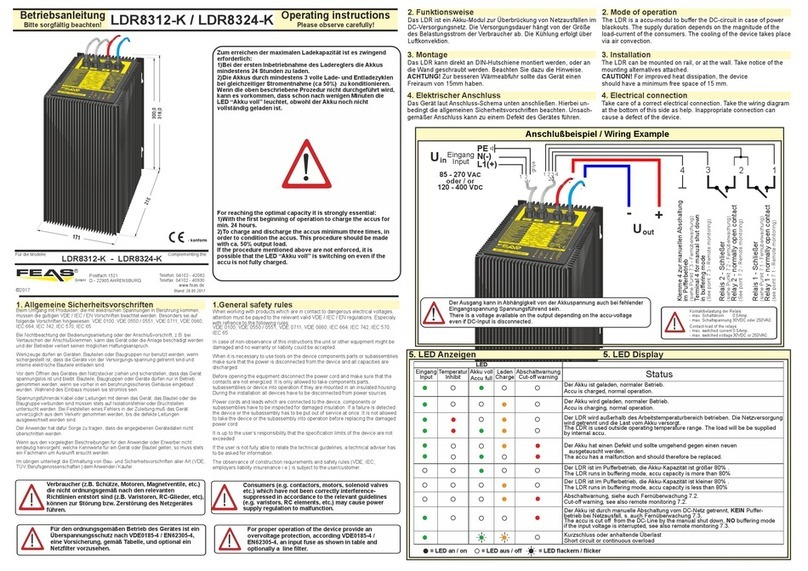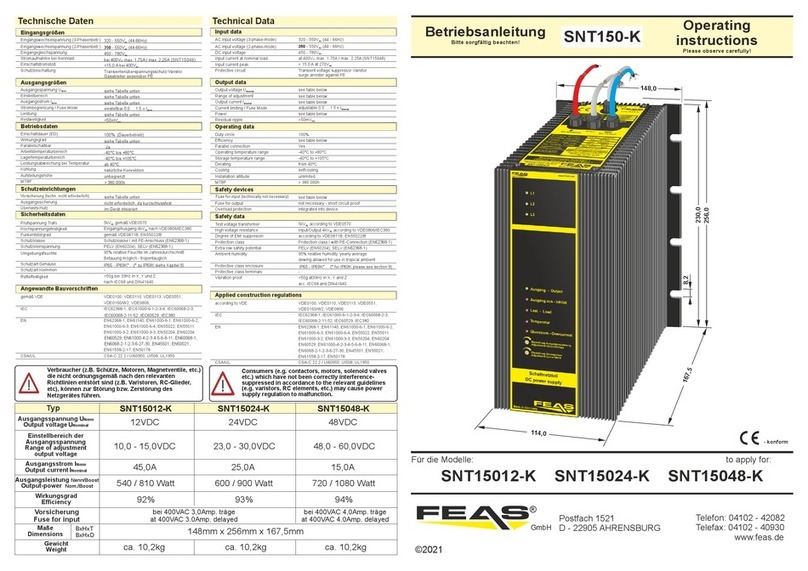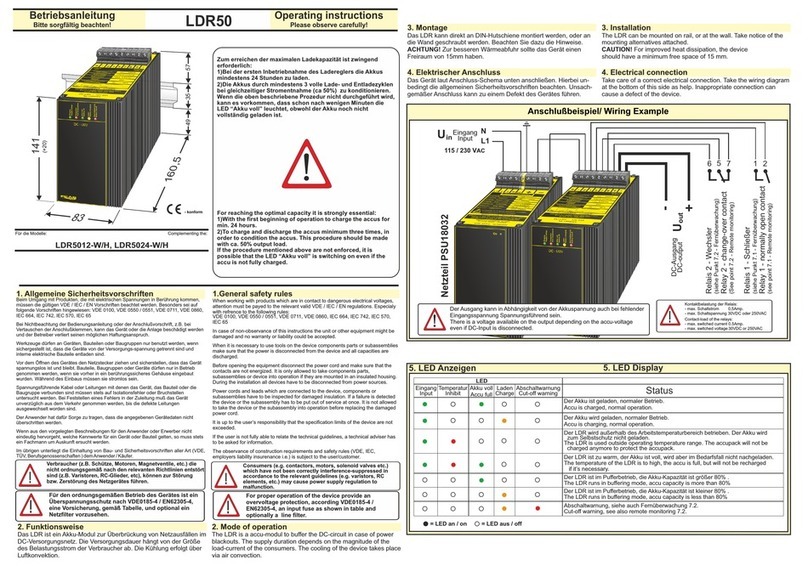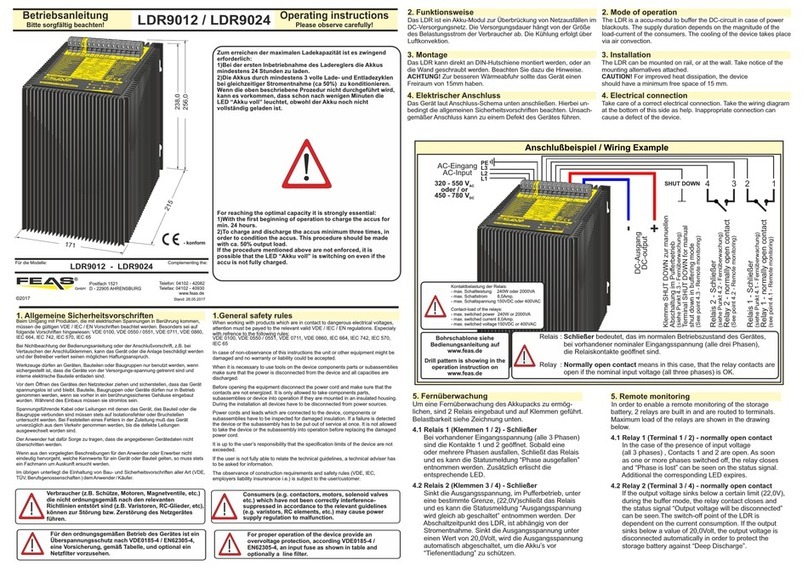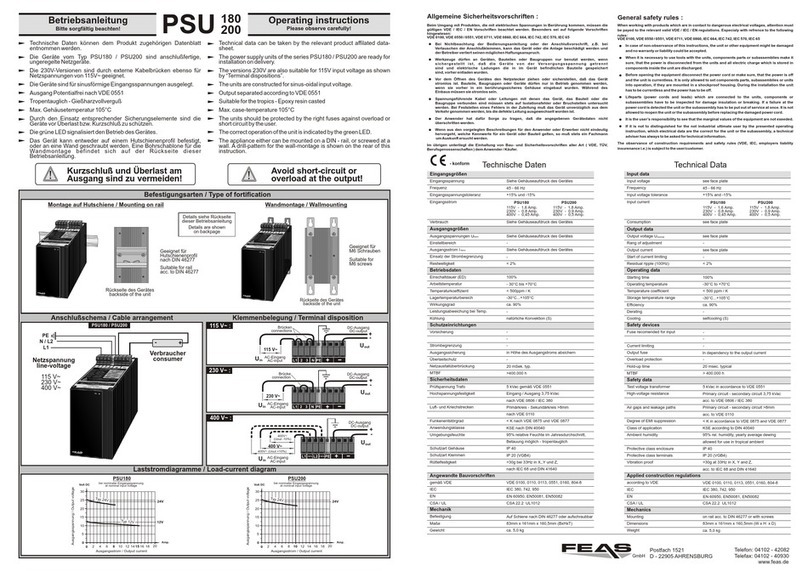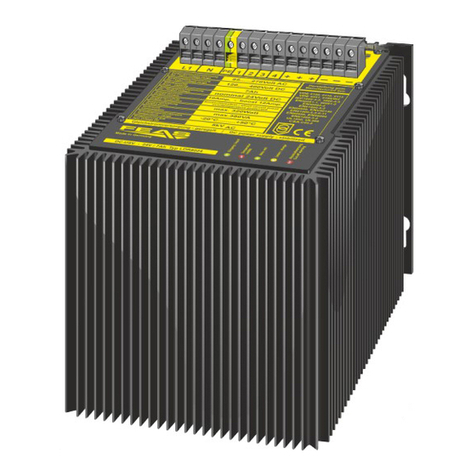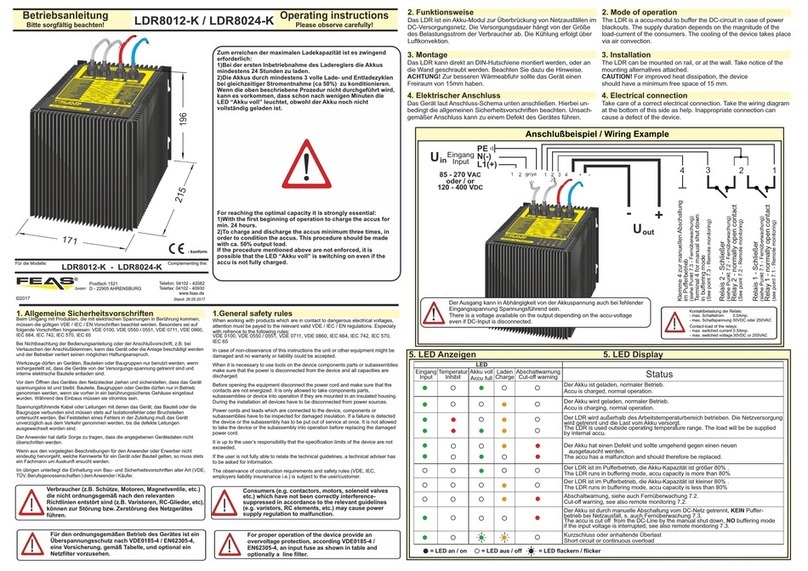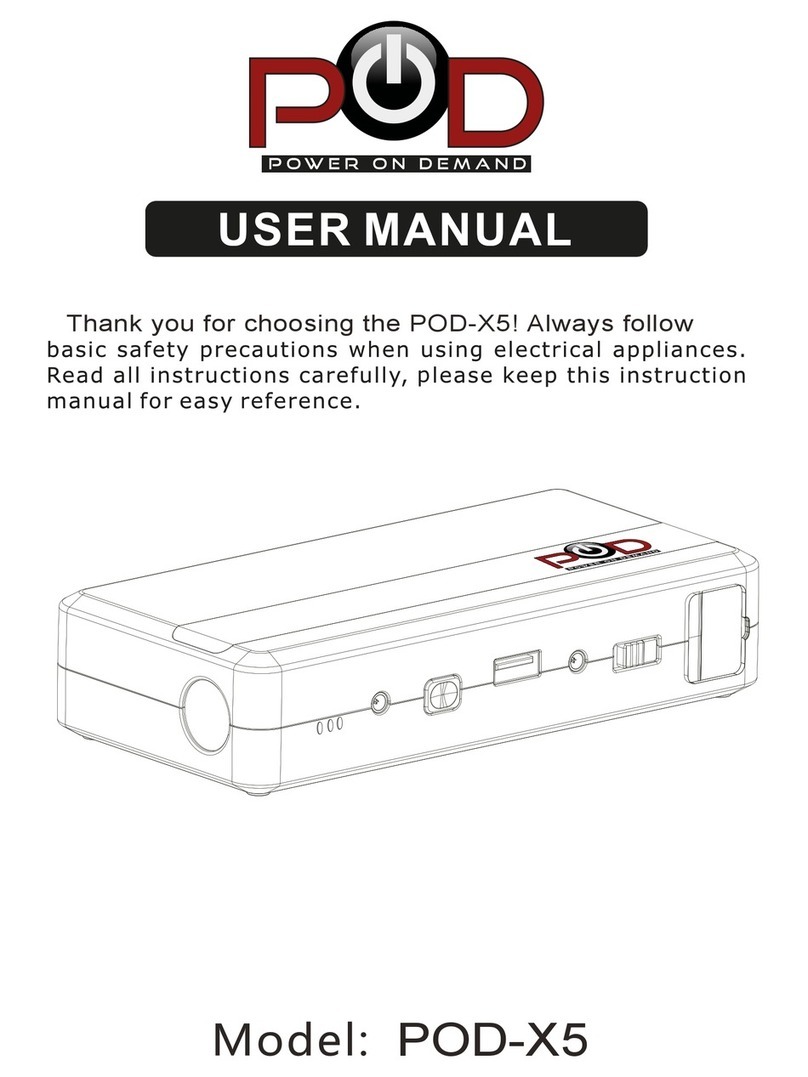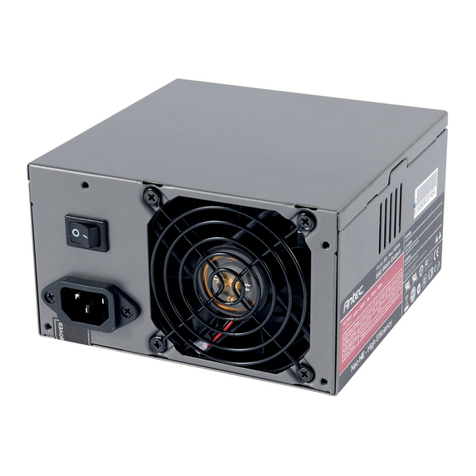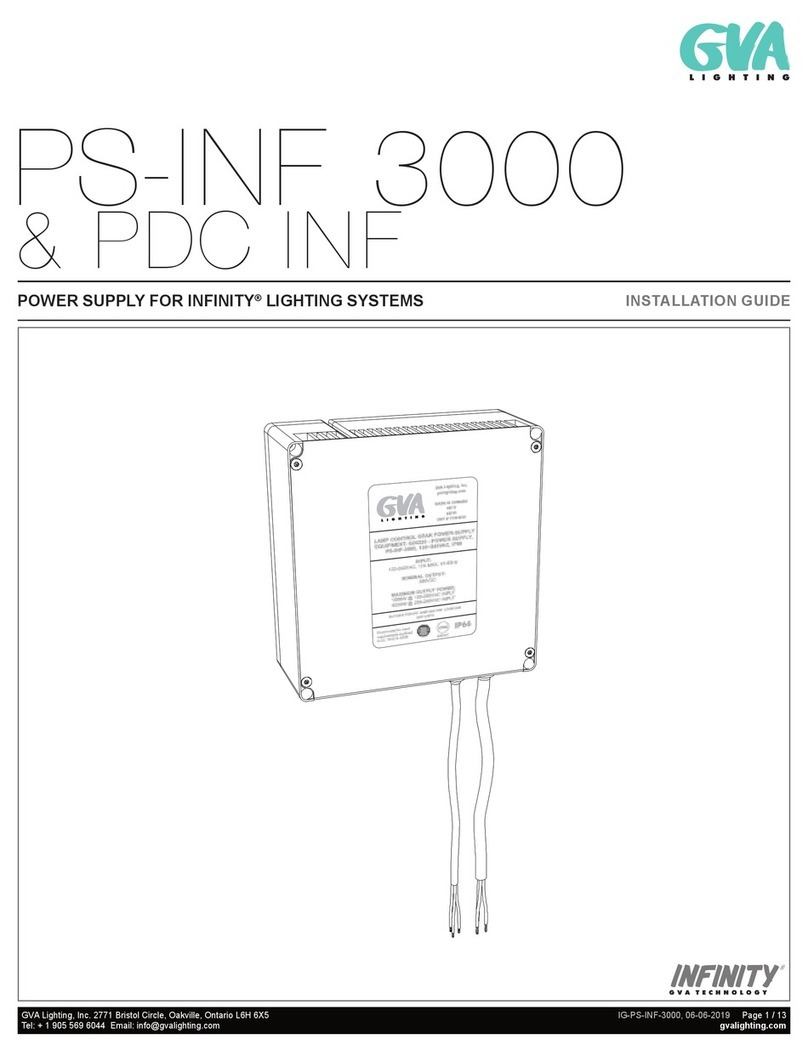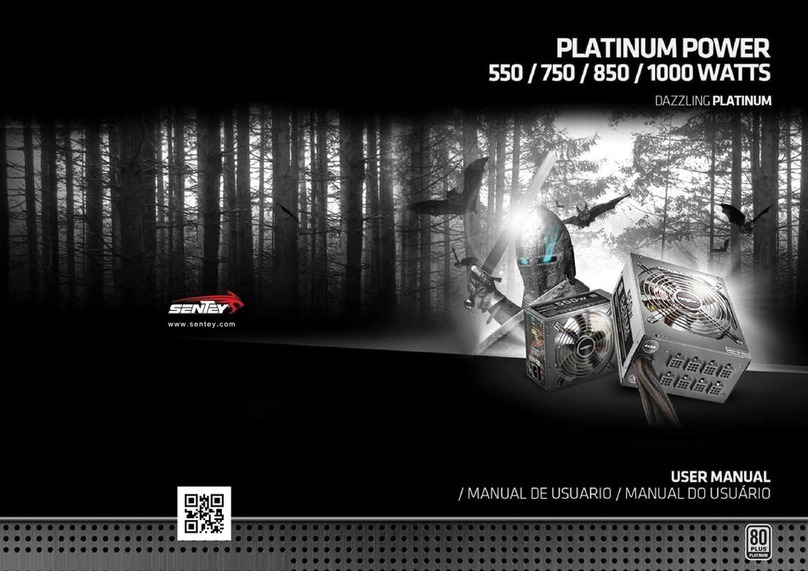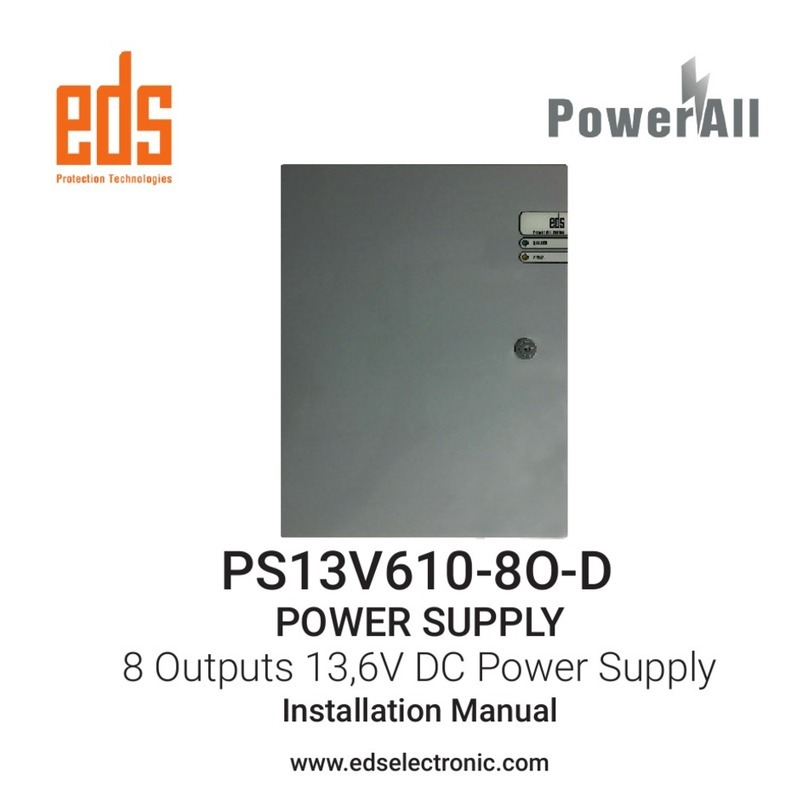FEAS SNT140-K User manual

Betriebsanleitung
Bitte sorgfältig beachten!
Operating
instructions
Please observe carefully!
SNT140-K
SNT14024-K & SNT14060-K
Für die Modelle: to apply for:
- konform
GmbH
Postfach 1521
D - 22905 AHRENSBURG
Telefon: 04102 - 42082
Telefax: 04102 - 40930
www.feas.de
©2022
®
Stand: 24.10.2022
1. Funktionsweise
Das SNT140-K ist ein Schaltnetzteil zur Speisung von
Verbrauchern aus dem Niederspannungsnetz. Die Kühlung
erfolgt über Luftkonvektion am Gehäuse-Kühlprofil. Bitte die
“Derating-Kurve” beachten.
1. Mode of operation
The SNT140-K is a power supply to supply consumers from
low voltage network.The cooling of the device takes place via
air convection at the case heatsink. Please observe the
derating
2. Montage
Das SNT140-K kann mit acht M8-Schrauben an eine Wand
geschraubt werden. Hierzu bitte die Bohrmaße auf der letzten
Seite beachten. ACHTUNG! Zur besseren Wärmeabfuhr sollte
das Gerät einen Freiraum von 15mm haben.
2. Installation
The SNT140-K can be mounted on a wall with eight M8-
screws. Take notice of the drilling dimensions on the last page.
CAUTION! For improved heat dissipation, the device
should have a minimum free space of 15 mm.
3. Elektrischer Anschluss
Das Gerät laut Anschluss-Schema unten anschließen. Hierbei
unbedingt die allgemeinen Sicherheitsvorschriften beachten.
Unsachgemäßer Anschluss kann zu einem Defekt des Gerätes
führen.
3. Electrical connection
Take care of a correct electrical connection. Take the wiring
diagram at the bottom of this side as help. Inappropriate
connection can lead to a defect of the device.
148,0
256,0
8,2
167,5
114,0
230,0
Anschlussschema / Wiring diagram
Only charge accumulators or
rechargeable batteries!
Nur Akkus oder
wiederaufladbare Batterien laden!
Auf Ladeschlussspannung der Batterie einstellen!
Adjust to maximum peak voltage of battery!
!
+
-
+
-Verbraucher
consumer
!
Kontaktbelastung der Relais:
- max. Schaltstrom 3,0 Amp.
- max. Schaltspannung 30V
Contact-load of the relays:
- max. switched current 3.0Amp.
- max. switched voltage 30V
!
Feineinstellung der
Ausgangsspannung
Fine-adjustment of
Output voltage
Feineinstellung der
Ausgangsstrom-
begrenzung
Fine-adjustment of
Output current
limitation
!
Bei Stromentnahme von mehr
als 25A muss der Strom
gleichmäßig über alle
Ausgangsklemmen verteilt
werden.
If the output current exceeds
25A, the output current has
to be uniformly distributed
over the whole output
terminals.
0,4
0,2
0
0,6
1,0
20100 30 50 70 90 10040 60 80
0,8
1,2
T / C°
Temperatur / temperature
Iout
Inenn
Dauerbetrieb
continuous duty
Boostbetrieb
boost mode
Powerboost
Derating
Ausgangsstrom
Output Current
Uout
Normalbetrieb - Standard function Schlafmodus - Standby
Das Gerät wird durch Setzen einer
Brücke zwischen Pin 4 und 5 in den
Schlafmodus versetzt. Es befindet
sich im Bereitschafsmodus, ist aber
von der Last getrennt.
The device is switched to sleep mode
by setting a bridge between pins 4
and 5. It is in standby mode but
disconnected from the load.
Feineinstellung der Ausgangsspannung
Diese sollte nicht im Fuse-Mode
erfolgen!
Fine-adjustment of Output voltage
This should not be made in Fuse
Mode
Feineinstellung der Ausgangs-
Strombegrenzung
Fine-adjustment of Output current
limitation
interne Relais-
Belegung
internal relays
assignment
SNT140-K
1
2
3
SNT140-K
1
2
3

5. Reset des Gerätes im Fehlerfall
Entweder bei Dauerkurzschluss oder wenn sich das Gerät im FuseMode befindet und einer der oben
beschriebenen Fehler auftritt, muss ein Reset durchgeführt werden.
Reset bei Dauerkurzschluss:
1. Pin 4 mit Pin 5 für einige Sekunden verbinden.
2. Danach wieder trennen und warten, bis das Gerät sich wieder gestartet hat.
Reset bei Übertemperatur nach dem Abkühlen: (für weitere Infos siehe Abschnitt „Übertemperatur erreicht“)
1. Pins 4 und 6 für 3 Sekunden kurzschließen, danach wieder öffnen. (automatischer FuseMode deaktiviert)
2. Pins 4 und 5 für 3 Sekunden kurzschließen, danach wieder öffnen. (Eigentlicher Reset)
3. Bei Bedarf FuseMode durch Brücke zwischen Pins 4 und 6 wieder aktivieren.
Reset nach Kurzschluss im FuseMode bzw.
Reset nach Überschreiten der Strombegrenzung im FuseMode:
1. Trennung der Verbindung zwischen Pin 4 und Pin 6.
2. Pin 4 mit Pin 5 für einige Sekunden verbinden.
3. Danach wieder trennen und warten, bis das Gerät sich wieder gestartet hat.
4. Für die Wiederherstellung des FuseMode-Zustandes Pin 4 und Pin 6 verbinden.
5. Reset of the unit in the event of a fault
Either in the event of a permanent short circuit or
if the unit is in FuseMode and one of the errors described above occurs, a reset must be carried out.
Reset in the event of a permanent short circuit:
1. Connect pin 4 to pin 5 for a few seconds.
2. Then disconnect again and wait until the unit has restarted.
Reset in case of overtemperature after cooling down: further infos see section "Overtemperature is reached")
1. Connect pins 4 and 6 for 3 seconds, then disconnect again. (automatic FuseMode deactivated)
2. Connect pins 4 and 5 for 3 seconds, then disconnect again. (Reset)
3. If desired, reactivate FuseMode by bridging pins 4 and 6.
Reset after short-circuit in FuseMode or
Reset after exceeding the current limit in FuseMode:
1. Disconnect pins 4 and 6.
2. Connect pin 4 with pin 5 for a few seconds.
3. Then disconnect again and wait until the unit has restarted.
4. To reactivate FuseMode, connect pin 4 and pin 6.
Überlast & Überschreiten der Strombegrenzung - Overload & exceeding current limit
Das Überschreiten des Nominalstroms INenn
(Überlast) zeigt das Gerät mit der gelben LED
„Last“ an.
Für die Fernüberwachung öffnet Relaiskontakt 2.
Die Zeit bis zum Abschalten der Last variiert je
nach Stromstärke (siehe Diagramm unter Punkt 7).
Bei Überschreiten der über den Drehregler
eingestellten Stromgrenze leuchten die LEDs
Überstrom und Ausgang rot.
Die Last wird getrennt.
4. LED Anzeigen 4. LED Display
LED-Anzeigen / LED-Display
Ausgang deaktiviert
Output off
ΔUout <±2%
ΔUout <±2%
keine Eingangsspannung
No Input
Eingangsspannung niedrig
Input low
Iout < INenn
Iout < Inominal
Temperatur OK
Temperature OK
Strom OK
Current OK
Normalbetrieb
Output active
Netz vorhanden
Input OK
Temperatur kritisch
Temperature critical
Netz OK
Input OK
INenn < Iout < IBoost
Inominal < Iout < IBoost
Temperatur zu hoch
Temperature to high
±2%< ΔUout <±10%
±2%< ΔUout <±10%
ΔUout >±10%
ΔUout >±10%
Netz - Line
Ausgang - Inhibit
Ausgang - Output
Netz -Line low
Last - Load
Temperatur
Überstrom -
Overcurrent
green
red
green
red
green
green
green
off
off
yellow
off
yellow
yellow
red
red
Ausgang - Output
Ausgang - Output Temperatur,
after
cool down
Überstrom -
Overcurrent
Ausgang - Output
red
red flashing red
redred
Kurzschluss, Last getrennt, wird nach kurzem
Kurschluss automatisch wieder zugeschaltet
Short circuit, load switched off, automatically
switched on again after short circuit
Übertemperatur, Last getrennt,
nach Abkühlung blinkt Temp. LED grün
Over-temperature, load switched off
after cooling down, Temp. LED flashes green
Strombegrenzung überschritten, Last getrennt
current limit exceeded, load switched off
+
+
=
=
=
Schlafmodus / Standby
Netz -
Line
Temp
/
green
Allgemeine Fehlermeldungen / Error messages
Mains low
Output
Overvoltage
off
off
Netzspannung
unter Last OK
Mains under load OK
Fremdspannung
am Ausgang OK
External voltage
at output OK
Netzspannung
unter Last nicht OK
Mains under load not OK
red
red Fremdspannung
am Ausgang nicht OK
External voltage
at output not OK
Fehlermeldungen im FuseMode / Error messages in FuseMode
+
=
Ausgang - Output red flashing
FuseMode ausgelöst, Last getrennt, Standby
FuseMode triggered, load switched off, standby
+=
Überstrom -
Overcurrent
Ausgang - Output red flashingred flashing +Kurzschluss, Last getrennt > Standby
Short circuit, load switched off > standby
=
Dauer-Kurzschluss, Last getrennt > Standby
Short circuit, load switched off > standby
=
Ausgang
Inhibit
+red
Überstrom -
Overcurrent
Ausgang - Output red
red
+Last
+yellow
Überstrom -
Overcurrent
Ausgang - Output red flashingred flashing
Übertemperatur, Last getrennt,
nach Abkühlung leuchtet Temp. LED gelb
Over-temperature, load switched off,
after cooling down, Temp. LED is yellow
Temperatur,
after
cool down
red
Ausgang - Output Verpolung am Ausgang, Last getrennt
Reverse polarity at ouput, load switched off
=
red/green flashing alternately
Überstrom -
Overcurrent /+
<>
Last -
Load off
Ausgang -
Output /
Ausgang -
Inhibit red
+
Mains
low
+red
yellow
green flashing
When the output current
INominal is exceeded, the
device indicates overload by
the yellow LED „Load“.
For remote monitoring relay-
contact 2 opens.
In case of too high overload,
simultaneously the output
voltage decreases, so the
message "Output" can also be
enabled.
When the set current limit is
exceeded the LEDs
Overcurrent and Output
glow red.
interne Relais-Belegung
internal relays assignment
SNT140-K
1
2
3
Kontakt 2
contact 2

6. Meldekontakte und Kontaktbelegung
Das Überwachungsmanagement des SNT140-K erlaubt eine Vielzahl an Einstellmöglichkeiten am Gerät und kann über zwei
integrierte Relais-Kontakte fernüberwacht werden.
Relaisbelegungen (Öffner):
1 : Relaismasse
1-2 : Bei Überlast, Kurzschluss, Notaus oder Fusemode
öffnet der Kontakt
1-3 : Überlast oder Übertemperatur (θ>85°C)
Bei Überlast oder wenn Kerntemperatur größer als
75°C ist öffnet der Kontakt.
Das Gerät schaltet bei 85°C selbstätig die Last ab.
Kontaktbelegungen:
4 : Signalmasse (Minus)
5-4 : Standby-Modus + Reset-Funktion
5 offen : Normalbetrieb aktivieren
6-4 : FuseMode aktivieren
6 offen : Strombegrenzung aktivieren
7-4 : 0-10V Schnittstelle
(x-x : Steckbrücke/ gebrückt)
6. Signal contacts and pin assignment
The monitoring management of the SNT140-K allows a variety of settings on the device. It can be remotely monitored via two
built-in relay contacts.
Signal contacts (Opener):
1 : Relayground
1-2 : In case of Overload, short circuit, emergency stop
or fuse mode the contact opens.
1-3 : Overload or Over-Temperature (θ>85°C)
In case of overload or if core temperature exceeds
75 ° C the contact opens.
The device switches the load off at 85 °C.
Pin assignment:
4 : Signalground (minus)
5-4 : Standby-Modus + Reset-Function
5 open : Normal operation active
6-4 : FuseMode active
6 open : Current limiting active
7-4 : 0-10V Interface
(x-x : Jumper/ bridged)
Fusemode ist aktiviert und Strombegrenzung wird überschritten
Fusemode is activated and Current-limit is exceeded
Wenn die elektronische Strombegrenzung
aktiviert ist (Fuse Mode), schaltet beim
Überschreiten der eingestellten Stromgrenze das
Gerät in Standby. Der Ausgang ist nun stromlos.
Relaiskontakt 2 ist geöffnet.
Dies geschieht auch beim Überschreiten der im
Diagramm (siehe Punkt 7) angegebenen
Überlastgrenze.
Bitte überprüfen Sie die angeschlossenen Systeme
auf Fehler.
Zum Neustart Verbindung zwischen Pin 4 und Pin 6
lösen und das Gerät durch kurzzeitiges Schließen
der Kontakte 4-5 zurückzusetzen.
If the electronic current limitation is activated (fuse
mode), the device switches automatically to standby
when the set current limit is exceeded. The output is
now de-energized. Relay contact 2 is open.
This also occurs if the overload limit shown in the
diagram (see point 7) is exceeded.
Please check the connected systems for errors.
In order to restart the device disconnect Pins 4-6
and reset the unit by bridging Pins 4-5 shortly.
Wird die elektronische Sicherung ausgelöst (bei
Fuse-Mode), blinken die LEDs Überstrom und
Ausgang rot. Die Last wird getrennt (gelbe LED)
(siehe auch LED-Anzeigen in Punkt 4)
Is the FuseMode triggered
the LEDs Overcurrent
and Output are red
flashing. The load is
disconnected (yellow LED)
(see also LED displays in
section 4)
Zur Anzeige der kritischen
Temperatur leuchtet die
LED Temperatur gelb.
To display the critical
temperature the LED
Temperatur glows yellow.
Wenn im Gerät die Temperatur etwa 75°C übersteigt,
wird der Relaiskontakt 3 geöffnet. Sie haben somit
die Möglichkeit, z.B. eine externe Lüftung zu
aktivieren. Das Relais bleibt solange geöffnet, bis ein
normaler Temperaturbereich erreicht wird.
If the device temperature rises above ~75°C, the
relay 3 opens. You have the opportunity, for
example to activate an external cooling. Relay-
contact 2 is opened, as long as the temperature is
critical.
Temperatur ist im kritischen Bereich - Temperature is in critical range
1
1
4 45 6
7
4
3
2Iout>
θunit>
interne Verdrahtung
internal wiring
Relais
Relay
1 2 3 4 5 6 7
1
1
4 45 6
7
4
3
2Iout>
θunit>
interne Verdrahtung
internal wiring
Relais
Relay
1 2 3 4 5 6 7
Reset
interne Relais-Belegung
internal relays assignment
SNT140-K
1
2
3
Kontakte 4-5
contacts 4-5
Uout
+
-Verbraucher
consumer
Lüfter
Fan
Relais
Relay
N
L1
interne Relais-Belegung
internal relays assignment
SNT140-K
1
2
3
12
3
4
5
6
7
Kontakt 3
contact 3
Der hier gezeigte Lüfter ist ein Vorschlag
zur Anwendung bei hohen Last- oder
Temperaturverhältnissen.
The fan shown here is a proposal for use
in high-load or temperature conditions.

7. Strombegrenzung und Fusemode
Das SNT140-K kann über den 7-poligen Stecker (Pins
4 und 6) in zwei Betriebsarten benutzt werden.
Strombegrenzung (Pin6 offen):
Über die Regelung des Potentiometers können Sie die
max. Stromstärke (0,5-1,2xI ) festlegen, an der das
nenn
Gerät die Last trennt und die Meldung über das Relais
erfolgt.
Dabei steht eine Leistung über 100% dem Anwender
nur für eine begrenzte Zeit zur Verfügung. Die Zeit ist
abhängig von der Höhe der (siehe Diagramm Leistung
unten). Nach Ablauf dieser Zeit trennt das Gerät für ca.
50 Sek. die Last und schaltet diese anschließend
wieder automatisch zu.
Zur Einstellung der Stromgrenze drehen Sie das
Potentiometer (Einstellung Stromgrenze) auf den
größtmöglichen Wert (im Urzeigersinn).
Stellen Sie die Last auf den Wert ein, an dem das
Netzteil die Last trennen soll.
Drehen Sie anschließend das Potentiometer zurück,
bis die Last getrennt wird.
Fuse-Mode (Pin4 und 6 gebrückt):
Durch eine Brücke zwischen Pin 4 und 6 wird die
elektronischen Sicherung (Fuse-Mode) aktiviert.
Die “Sicherung” löst aus:
wenn die von Ihnen eingestellte Strombegrenzung,
oder die zeitliche Begrenzung der Last (siehe
Diagramm) überschritten wird.
Bei Fuse-Mode schaltet das Gerät die Last sofort ab
und geht in Standby. Ein Neustart ist erst nach
manuellem Reset möglich.
7. Current-Limiting and Fusemode
The SNT140-K can be used in two different modes by
using the 7-pin plug (Pins 4 and 6) and the
potentiometer (Current limit).
Current limit (Pin6 open):
With the regulation of the potentiometer you can set up
the current (0.5-1.2xI ) on which the device limiter tilts
nom
and the message “overload” on relay 2 is displayed.
A performance more than 100% is only available for a
limited time. The time depends on the level (see
diagram below). After this time the device disconnects
the load for approx. 50 seconds and then switches it
on again automatically.
To set the current limit, turn the potentiometer
(Adjustment Current limit) to the highest possible
value (clockwise).
Set the load of your device to the value at which the
power supply should disconnect the load.
Then turn the potentiometer back until the load is
disconnected.
Fuse-Mode (Pin4 and 6 bridged)
A bridge between pins 4 and 6 activates the electronic
fuse (fuse mode).
The „fuse“ triggers:
if the current limit,
or the time limit of the load (see diagram) is exceeded.
In fuse mode, the device switches off the load
immediately and goes into standby. A restart is only
possible after a manual reset.
Überlastverhalten
Over-Load-characteristic
80%
100%
110%
Ausgangsstrom
Output Current
1 2 4 5 6
Zeit / Time (min.)
Betriebsbereich / Operation range
120%
7
3
Der hier gezeigte Lüfter
ist ein Vorschlag zur
Anwendung bei hohen
Last- oder Temperatur-
verhältnissen.
The fan shown here is
a proposal for use in
high-load or
temperature conditions.
A manual reset is only possible after a longer cooling phase. Sufficient
cooling is indicated by a green flashing of the "Temperature" LED
(or by a yellow LED if Fusemode was previously activated by the customer).
Ein manueller Reset ist erst nach einer längeren Abkühlphase möglich.
Eine ausreichende Abkühlung wird durch ein grünes Blinken der LED
"Temperatur" angezeigt (oder durch eine gelbe LED, wenn Fusemode
durch den Kunden zuvor aktiviert war).
Übertemperatur erreicht - Over-Temperature is reached
To indicate the error, the
temperature LED is red and
the output LED flashes red.
After cooling down, the LED
temperature flashes green
again.
Attention: If Fusemode was
set before, the temperature
LED is yellow after cooling
down.
Sollte die Gerätetemperatur auf über 85°C steigen,
öffnet Temperatur Relais 1-3, die interne Schutz-
schaltung schaltet automatisch die Last ab, das
Gerät wechselt automatisch intern in FuseMode und
geht in Standby.
Nach dem Abkühlen ist ein manueller Reset nötig:
1. Kontakte 4-6 für 3 Sekunden kurzschließen und
danach wieder öffnen. (Damit wird der automatisch
intern gesetzte FuseMode deaktiviert.)
2. Kontakte 4-5 für 3 Sekunden kurzschließen und
danach wieder öffnen. (Eigentliches Reset)
Die Last wird automatisch wieder freigeschaltet.
Das Relais 1-3 schließt wieder.
3. Bei Bedarf FuseMode wieder durch Brücke
zwischen Kontakten 4-6 aktivieren.
If the device temperature rises above 85°C,
temperature relay 1-3 opens, the internal protection
automatically switches off the load, the device
automatically changes internally to FuseMode and
goes into standby.
After cooling down, a manual reset is necessary:
1. Connect contacts 4-6 for 3 seconds and then
disconnect them. (This deactivates the
automatically internally set FuseMode)
2. Connect contacts 4-5 for 3 seconds and then
disconnect them. (Actual reset)
The load is automatically enabled again.
3. If desired, reactivate FuseMode by bridging
contacts 4-6.
Zur Anzeige des Fehlers
leuchtet die LED Temperatur
rot und LED Ausgang blinkt
rot.
Nach dem Abkühlen blinkt die
Temperaturanzeige wieder grün.
Achtung: Wenn zuvor
Fusemode eingestellt war,
leuchtet die Temperatur LED
danach gelb.
Uout
+
-Verbraucher
consumer
Lüfter
Fan
Relais
Relay
N
L1
interne Relais-Belegung
internal relays assignment
SNT140-K
1
2
3
Kontakt 3
contact 3

8. 0-10V Schnittstelle (Dimmer)
Auch über die 0-10V-Schnittstelle (Kontakte 7-4, siehe
Abschnitt 6) kann die Ausgangsspannung des
SNT140-K eingestellt werden.
Die Ansteuerung der Schnittstelle erfolgt über ein
störungssicheres Gleichspannungssignal
von 0V (min. Ausgangsspannung 23,0V / 60,0V)
bis 10V (max. Ausgangsspannung 30,0V / 72,0V).
Aufgrund der Eigenschaften dieser Schnittstelle
müssen folgende Punkte beachtet werden:
q Um die Schnittstelle zu verwenden ist das
eingebaute Potentiometer “Uadj” auf die höchste
Ausgangsspannung einzustellen.
q Die Steuerleistung wird vom Netzteil selbst erzeugt
(max. Strom 1mA pro Netzteil). Dies ermöglicht eine
einfache Verstellung der Ausgangsspannung mit nur
einem Widerstand an den Klemmen der Schnittstelle.
q Die Steuerleitung ist potentialgetrennt von der
Eingangsspannung, jedoch nicht von der
Ausgangsspannung des Netzteils.
q Ein angeschlossenes Steuergerät muss in der Lage
sein, den von den Netzteilen in die Steuerleitung
gelieferten Strom aufzunehemen (Stromsenke) und die
Steuerspannung zu verringern. Nicht alle Netzgeräte,
Wandlerkarten usw. haben diese Eigenschaften!
q Die Steuerleitung muss mit richtiger Polarität (+ / -)
angeschlossen werden.
8. 0-10V Interface (Dimmer)
Via the 0-10V interface (contacts 7-4, see section 6)
the output voltage of the SNT140-K can be adjusted.
The interface will be controlled by an interference
proof DC-Voltage from 0V (min. output voltage 23,0V /
60,0V)
to 10V (max. output voltage 30,0V / 72,0V).
Because of the special attributes of this interface the
following issues should be observed:
q To operate the interface, the integrated
potentiometer “Uadj” has to be adjust to the maximum
output voltage.
q The power supply generates the control power by
itself (max. current 1mA each power supply). This
allows an adjustment of the output voltage by using a
resistor connected to the terminals of the interface.
q The control wire is potential separated from
the input voltage, but not from the output voltage.
q The connected controller has to be able to take the
control current of the power supplies (current sink) and
to lower the control voltage. Please notice that not all
power supplies, transformer cards etc. have these
features.
q The control wire has to be connected with the
correct polarity (+ / -).
Kennlinien / Characteristic curves
Zur Bestimmung der Steuerspannung oder des
Steuerwiderstandes siehe nachfolgende Kennlinien.
To determine the control voltage or the control
resistance, see the following characteristic curves.
9. Allgemeine Sicherheitsvorschriften
Beim Umgang mit Produkten, die mit elektrischen Spannungen in
Berührung kommen, müssen die gültigen VDE / IEC / EN Vorschriften
beachtet werden. Besonders sei auf folgende Vorschriften hingewiesen:
VDE 0100, VDE 0550 / 0551, VDE 0711, VDE 0860, IEC 664, IEC 742, IEC
570, IEC 65
Bei Nichtbeachtung der Bedienungsanleitung oder der Anschlussvorschrift,
z.B. bei Vertauschen der Anschlussklemmen, kann das Gerät oder die
Anlage beschädigt werden und der Betreiber verliert seinen möglichen
Haftungsanspruch.
Durch den vollständigen Verguss darf das Gerät nicht geöffnet werden,
andernfalls erlöschen jeglicher Garantie- und Haftungsanpruch.
Werkzeuge dürfen an Geräten, Bauteilen oder Baugruppen nur benutzt
werden, wenn sichergestellt ist, dass die Geräte von der Versorgungs-
spannung getrennt sind und interne elektrische Bauteile entladen sind.
Vor dem Öffnen des Gerätes den Netzstecker ziehen und sicherstellen,
dass das Gerät spannungslos ist und bleibt. Bauteile, Baugruppen oder
Geräte dürfen nur in Betrieb genommen werden, wenn sie vorher in ein
berührungssicheres Gehäuse eingebaut wurden. Während des Einbaus
müssen sie stromlos sein.
Spannungsführende Kabel oder Leitungen, mit denen das Gerät, das
Bauteil oder die Baugruppe verbunden sind, müssen stets auf
Isolationsfehler oder Bruchstellen untersucht werden. Bei Feststellen eines
Fehlers in der Zuleitung muß das Gerät unverzüglich aus dem Verkehr
genommen werden, bis die defekte Leitungen ausgewechselt worden sind.
Der Anwender hat dafür Sorge zu tragen, dass die angegebenen
Gerätedaten nicht überschritten werden.
Wenn aus den vorgelegten Beschreibungen für den Anwender oder
Erwerber nicht eindeutig hervorgeht, welche Kennwerte für ein Gerät oder
Bauteil gelten, so muss stets ein Fachmann um Auskunft ersucht werden.
Im Übrigen unterliegt die Einhaltung von Bau- und Sicherheitsvorschriften
aller Art ( VDE, TÜV, Berufsgenossenschaften ) dem Anwender / Käufer.
9.General safety rules
When working with products which are in contact to dangerous electrical
voltages, attention must be payed to the relevant valid VDE / IEC / EN
regulations. Especialy with refrence to the following rules:
VDE 0100, VDE 0550 / 0551, VDE 0711, VDE 0860, IEC 664, IEC 742, IEC
570, IEC 65
In case of non-observance of this instructions the unit or other equipment
might be damaged and no warranty or liability could be accepted.
The device must not be opened as a result of complete potting, otherwise
all warranty and liability claims will lapse.
When it is necessary to use tools on the device components parts or
subassemblies make sure that the power is disconnected from the device
and all capacities are discharged.
Before opening the equipment disconnect the power cord and make sure
that the contacts are not energized. It is only allowed to take components
parts, subassemblies or device into operation if they are mounted in an
insulated housing. During the installation all devices have to be
disconnected from power sources.
Power cords and leads which are connected to the device, components or
subassemblies have to be inspected for damaged insulation. If a failure is
detected the device or the subassembly has to be put out of service at
once. It is not allowed to take the device or the subassembly into operation
before replacing the damaged power cord.
It is up to the user’s responsibility that the specification limits of the device
are not exeeded.
If the user is not fully able to relate the technical guidelines, a technical
adviser has to be asked for information.
The observance of construction requirements and safety rules (VDE, IEC,
employers liability insurenance i.e.) is subject to the user/customer.
22
23
24
25
26
27
28
29
30
0 0,5 1 1,5 2 2,5 3 3,5 4 4,5 5 5,5 6 6,5 7 7,5 8 8,5 9 9,5 10
Ua-Uc-Kennlinie / Characteristic curve
SNT1424-K
Ua / V
Steuerspannung / Control voltage
Ausgangsspannung
Output voltage
Uc / V
1k0
3k32
10k0
20k0
100k0
475k0
1M0
Steuerwiderstand
nach E96-Reihe
.
Control resistor
acc. to E96-Series
Ausgangsspannung
SNT14024-K
.
Output voltage
SNT14024-K
23,18VDC
24,04VDC
25,64VDC
26,92VDC
29,19VDC
29,97VDC
30,09VDC
22
22,5
23
23,5
24
24,5
25
25,5
26
26,5
27
27,5
28
28,5
29
29,5
30
0,1 1 10 100 1000
Ua / V
Ua-Rc-Kennlinie / Characteristic curve
SNT14024-K
Rc / kW
Steuerwiderstand / Control resistor
Ausgangsspannung
Output voltage
2 3 4 20 30 40 200 300
0,2 0,3
60
61
62
63
64
65
66
67
68
69
70
71
72
73
74
0,1 1 10 100 1000
Ua / V
Rc / kW
Steuerwiderstand / Control resistor
2 3 4 20 30 40 200 300
0,2 0,3
Ausgangsspannung
Output voltage
Ua-Rc-Kennlinie / Characteristic curve
SNT14060-K
60
62
64
66
68
70
72
74
0 0,5 1 1,5 2 2,5 3 3,5 4 4,5 5 5,5 6 6,5 7 7,5 8 8,5 9 9,5 10
Ua-Uc-Kennlinie / Characteristic curve
SNT14060-K
Ua / V
Steuerspannung / Control voltage
Ausgangsspannung
Output voltage
Uc / V
>10 MΩ
1 MΩ
300 kΩ
10 kΩ
4 kΩ
400 Ω
Steuerwiderstand
nach E96-Reihe
.
Control resistor
acc. to E96-Series
Ausgangsspannung
SNT14060-K
.
Output voltage
SNT14060-K
72,36 VDC
72,36 VDC
72,34 VDC
70,87 VDC
66,70 VDC
61,02 VDC
0,1 Ω61,32 VDC
Beispiele für die
Ausgangsspannung, gesteuert
durch einen an der Schnittstelle
angeschlossenen Widerstand.
Examples for the output voltage
controlled by a resistor,
connected to the interface.
device
e.g. SNT140-K
Grobschutz
Surge protective
devices
Typ1
>1300V
Mittelschutz
Surge protective
devices
Typ2
>600V
Feinschutz
Surge protective
devices
Typ3
<600V
Netzfilter
linefilter
optional
e.g. FEAS NFK
VDE0185-4 / EN62305-4
Blitz- und
Transientenschutz
lightning and over-
voltage protection
EMV Schutz
EMC protection
Für den ordnungsgemäßen Betrieb des
Gerätes ist ein Überspannungsschutz nach
VDE0185-4 / EN62305-4, und ein Netzfilter
vorzusehen.
For proper operation of the device provide an
overvoltage protection, according VDE0185-4 /
EN62305-4, and a line filter.
Aufgrund der internen Transienten-
Schutzschaltung darf die Isolationsprüfung
Ihrer Anlage nicht mit unserem Gerät erfolgen.
Due to the internal transient protection circuit,
the insulation test of your system must not be
carried out with our device.
IP65 - IP69K: Um Schutzklasse IP69K zu
erreichen, müssen die Poti-Öffnungen mit
einem 2-Komponenten-System zuverlässig
abgedichtet werden. Wenn dies nicht erfolgt,
liegt die Schutzklasse IP65 vor.
IP65 - IP69K: To achieve protection class
IP69K, the potentiometer openings must be
reliably sealed with a 2-component system. If
this is not done, the protection class is IP65.

Typ
Ausgangsleistung Nenn/Boost
Output-power Nom./Boost
Ausgangsstrom INenn
Output current INominal
Wirkungsgrad
Efficiency
Maße
Dimensions
Gewicht
Weight
BxHxT
BxHxD
23,0 - 30,0VDC
SNT14024-K
148mm x 256mm x 167,5mm
35,0A
840 / 1008 Watt
95%
ca. 11,0kg
Einstellbereich der
Ausgangsspannung
Range of adjustment
output voltage
Vorsicherung
Fuse for input
bei 115VAC 14,0Amp. träge / bei 230VAC 7,0Amp. träge
at 115VAC 14.0Amp. delayed / at 230VAC 7.0Amp. delayed
Schutzeinrichtungen
bei 115 VAC 14A träge / bei 230 VAC 7,0A träge
nicht erforderlich, da kurzschlussfest
im Gerät integriert
Vorsicherung
Ausgangssicherung
Überlastschutz
Eingangsgrößen
85 - 270V (44 - 66Hz)
AC
120 - 400VDC
bei 115VAC max. 8,4A /bei 230VAC max. 4,2A
<10,0 A bei 270VAC
Transientenüberspannungsschutz-Varistor
Gasableiter gegenüber PE
Eingangswechselspannung
Eingangsgleichspannung
Stromaufnahme bei Nennlast
Einschaltstromstoß
Schutzbeschaltung
Sicherheitsdaten
Prüfspannung Trafo 5kV gemäß VDE0570
AC
Hochspannungsfestigkeit Eingang/Ausgang 4,4kV nach VDE0806/IEC380
AC
L/N - PE = 1500VAC; out - PE = 500VDC
Funkentstörgrad gemäß EN55022
95% relative Feuchte im Jahresdurchschnitt
Betauung möglich - tropentauglich
Schutzklasse
Umgebungsfeuchte
Schutzart Gehäuse
Schutzklasse I mit PE-Anschluss (EN62368-1)
Schutzart Klemmen -
Rüttelfestigkeit >50g bei 33Hz in X, Y und Z
nach IEC68 und DIN41640
Schutzkleinspannung PELV (EN60204), SELV (EN62368-1, EN60950-1)
Betriebsdaten
100% (Dauerbetrieb)
-40°C bis 80°C
Einschaltdauer (ED)
Arbeitstemperaturbereich
-40°C bis 105°C
Ja
ab 40°C
Lagertemperaturbereich
Parallelschaltbar
Leistungsabweichung bei Temperatur
natürliche KonvektionKühlung
Wirkungsgrad siehe Tabelle unten
Aufstellungshöhe
MTBF
unbegrenzt
> 380.000h
Ausgangsgrößen
siehe Tabelle unten
siehe Tabelle unten
einstellbar 0,5 ... 1,2 x INenn
Ausgangsspannung UNenn
Ausgangsstrom INenn
Strombegrenzung / Fuse Mode
Leistung
Restwelligkeit (20MHz Bandbreite)
siehe Tabelle unten
<100mVrms
Einstellbereich siehe Tabelle unten
10. Technische Daten
Safety devices
at 115 VAC 14A delayed / at 230 VAC 7.0A delayed
not necessary - short circuit proof
integrated into device
Fuse for input
Fuse for output
Overload protection
Input data
85 - 270V (44 - 66Hz)
AC
120 - 400VDC
at 115VAC max. 8.4A / at 230VAC max. 4.2A
< 10.0 A at 270VAC
Transient voltage suppressor Varistor
surge arrester
AC input voltage
DC input voltage
Input current at nominal load
Input current peak
Protective circuit
Safety data
Test voltage transformer 5kV according to VDE0570
AC
High voltage resistance Input/Output 4,4kV according to VDE0806/IEC380
AC
L/N - PE = 1500VAC; out - PE = 500VDC
Degree of EMI suppresion according to VDE0871B, EN55022/B
95% relative humidity, yearly average
dewing allowed for use in tropical ambient
Protection class
Ambient humidity
Protective class enclosure
Protection class I with PE-Connection (EN62368-1)
Protective class terminals -
Vibration proof >50g at 33Hz in X, Y and Z
acc. IEC68 and DIN41640
Extra low safety potential PELV (EN60204), SELV (EN62368-1)
Operating data
100%
-40°C to 80°C
Duty circle
Operating temperature range
-40°C to 105°C
Yes
from 40°C
Storage temperature range
Parallel connection
Derating
selfcoolingCooling
Efficiency see table below
Installation altitude
MTBF
unlimited
> 380.000h
Output data
see table below
see table below
adjustable 0.5 ... 1.2 x INominal
Output voltage UNominal
Output current INominal
Current limiting / Fuse Mode
Power
Residual ripple (20MHz Bandwidth)
see table below
<100mVrms
Range of adjustment see table below
10. Technical Data
Angewandte Bauvorschriften Applied construction regulations
Verbraucher (z.B. Schütze, Motoren, Magnetventile, etc.)
die nicht ordnungsgemäß nach den relevanten
Richtlinien entstört sind (z.B. Varistoren, RC-Glieder,
etc), können zur Störung bzw. Zerstörung des
Netzgerätes führen.
Consumers (e.g. contactors, motors, solenoid valves
etc.) which have not been correctly interference-
suppressed in accordance to the relevant guidelines
(e.g. varistors, RC elements, etc.) may cause power
supply regulation to malfunction.
Ausgangsspannung UNenn
Output voltage UNominal 24VDC
CSA/UL CSA-C 22.2 / UL60950, UL508, UL1950
gemäß VDE
IEC
EN
VDE0100, VDE0110, VDE0113, VDE0806
IEC61000-6-1,2,3,4, IEC60068-2-3,
IEC60068-2-11,52, IEC60529
EN61140, EN61000-6-1,2,3,4, EN55011,
EN61000-3-2,3, EN61000-4-2-3-4-5-6-8-11,
EN60204, EN60529, EN60068-1, EN60068-2-1,
EN61010-1, EN62040-1,2, EN61558-2-16,
EN55032, EN55024
EN61000-6-2-3-4,
CSA/UL CSA-C 22.2 / UL60950, UL508, UL1950
IEC
EN
VDE0100, VDE0110, VDE0113, VDE0806
according to VDE
IEC61000-6-1,2,3,4, IEC60068-2-3,
IEC60068-2-11,52, IEC60529
EN61140, EN61000-6-1,2,3,4, EN55011,
EN61000-3-2,3, EN61000-4-2-3-4-5-6-8-11,
EN60204, EN60529, EN60068-1, EN60068-2-1,
EN61010-1, EN62040-1,2, EN61558-2-16,
EN55032, EN55024
EN61000-6-2-3-4,
60,0 - 72,0VDC
SNT14060-K
15,0A
900 / 1080 Watt
95%
60VDC
IP65 - IP69K* (* zu IP69K siehe Kapitel 9) IP65 - IP69K* (* for IP69K please see section 9)
148,0
230,0
54,0
34,0 54,0 54,0
34,0
133,2
7,4 7,4
Suitable for M8 screws
All dimensions in millimeter
Ÿ3 in 1, vereint Schaltnetzteil, Ladekontrolleinheit
und Akku in einem sehr kompakten Gehäuse
ŸPufferung eines Verbrauchers bei Netzausfall
ŸPufferzeit begrenzbar (1-20 Minuten und unbegrenzt)
ŸIm Pufferbetrieb manuell abschaltbar, “Schlafenlegen”
ŸIntegrierter NiMH Akkumulator mit 0,72 Ah (austauschbar)
ŸMikroprozessorgesteuerte Akkumulator-Überwachung und
Ladeanzeige
ŸLED-Anzeigen für Netzausfall, Übertemperatur, Überlast,
Akku laden, Akku Alarm, Pufferbetrieb
ŸRelais-Meldung von Netzausfall, Übertemperatur, Akku-
Defekt und Akkuspannung kritisch
LDR30MH24
Mini DC-USV für die Hutschiene
Art.Nr.: 589960
Maße Rückseite - Dimensions backside
GmbH
Postfach 1521
D - 22905 AHRENSBURG
Telefon: 04102 - 42082
Telefax: 04102 - 40930
www.feas.de
Abhängig von der entnommenen Ausgangsleistung
und Kühlsituation kann sich die Gehäuseoberfläche
bis zu 80°C erwärmen.
Depending on the output power and cooling
situation, the surface of the Alu-housing can heat up
to 80°C.
This manual suits for next models
3
Table of contents
Other FEAS Power Supply manuals
Popular Power Supply manuals by other brands

Relcross Door Controls
Relcross Door Controls PS01 instruction manual
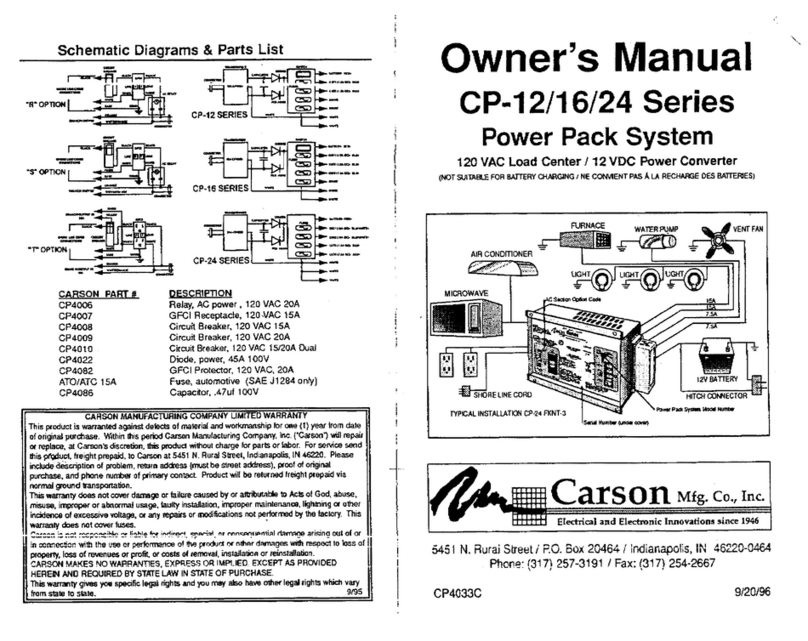
Carson
Carson CP-12 Series owner's manual
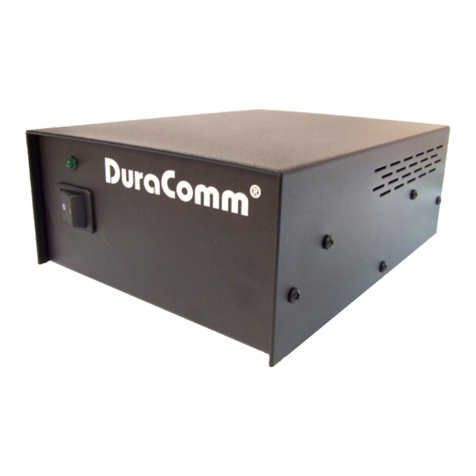
DuraComm
DuraComm LPB-12 owner's guide
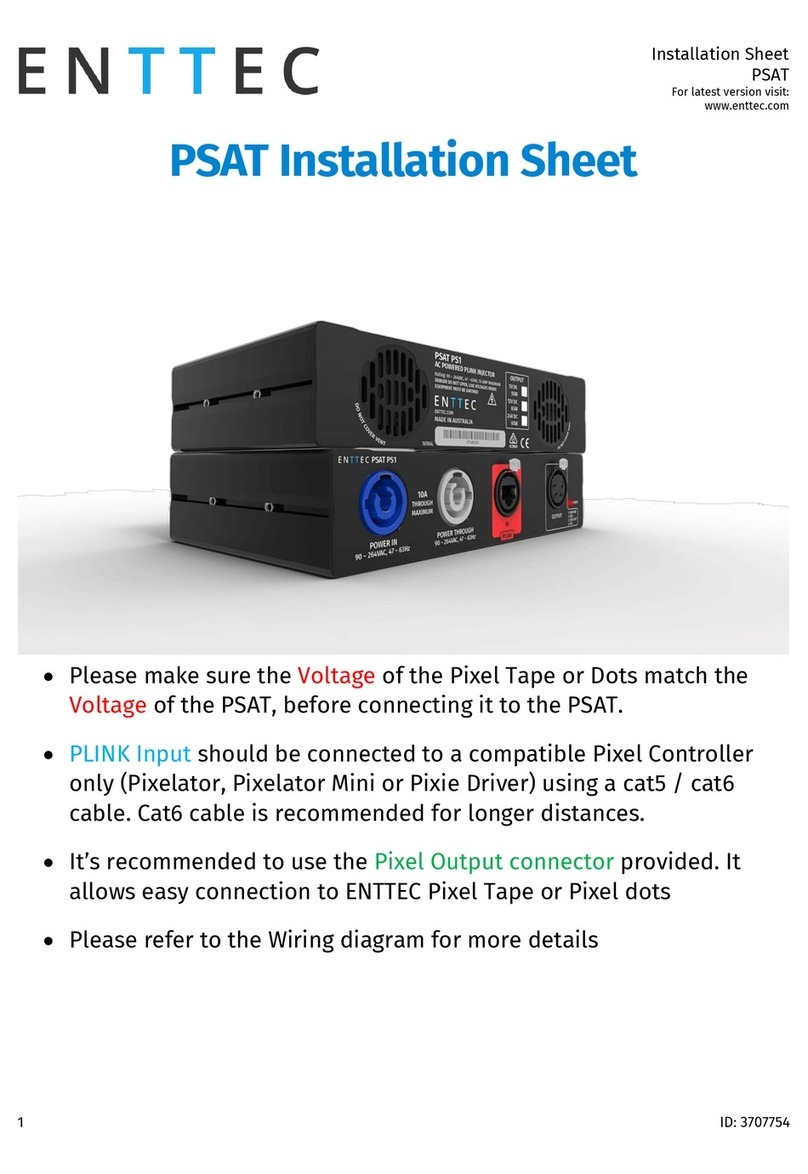
Enttec
Enttec PSAT Installation sheet
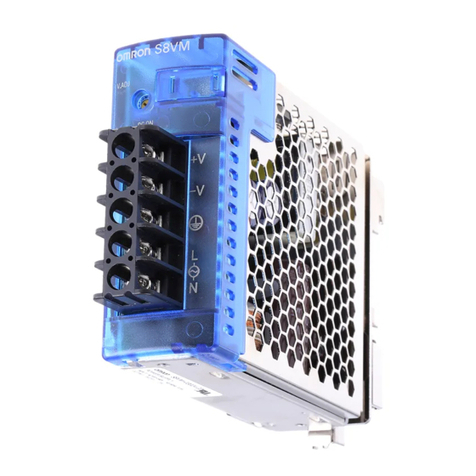
Omron
Omron S8VM Series Product information
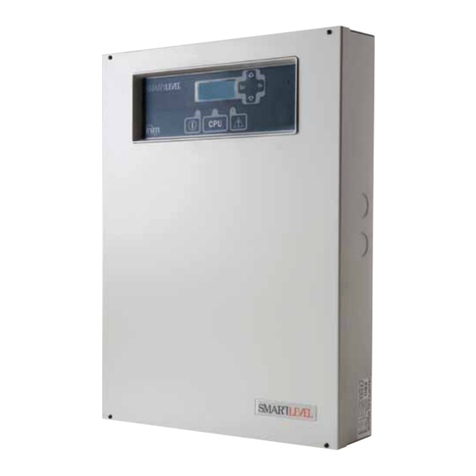
INIM Electronics
INIM Electronics SmartLevel SPS24040 Installation and programming manual
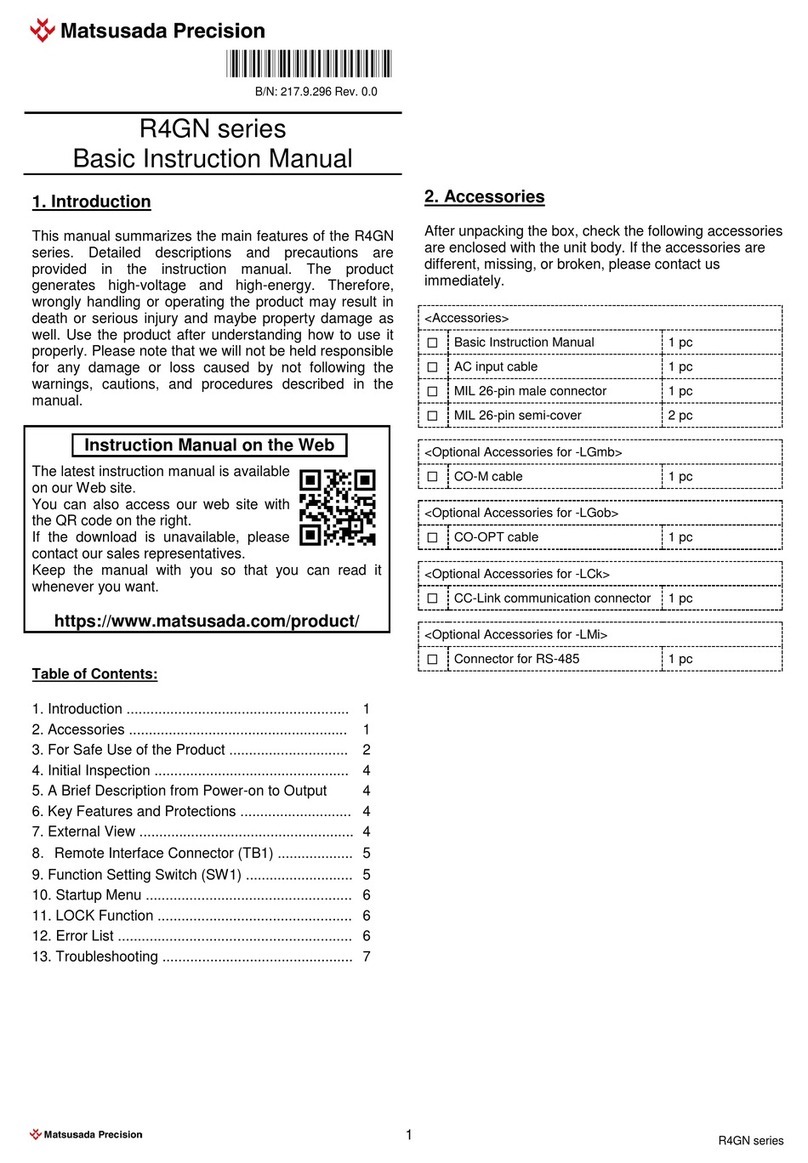
Matsusada Precision
Matsusada Precision R4GN Series Basic instruction manual
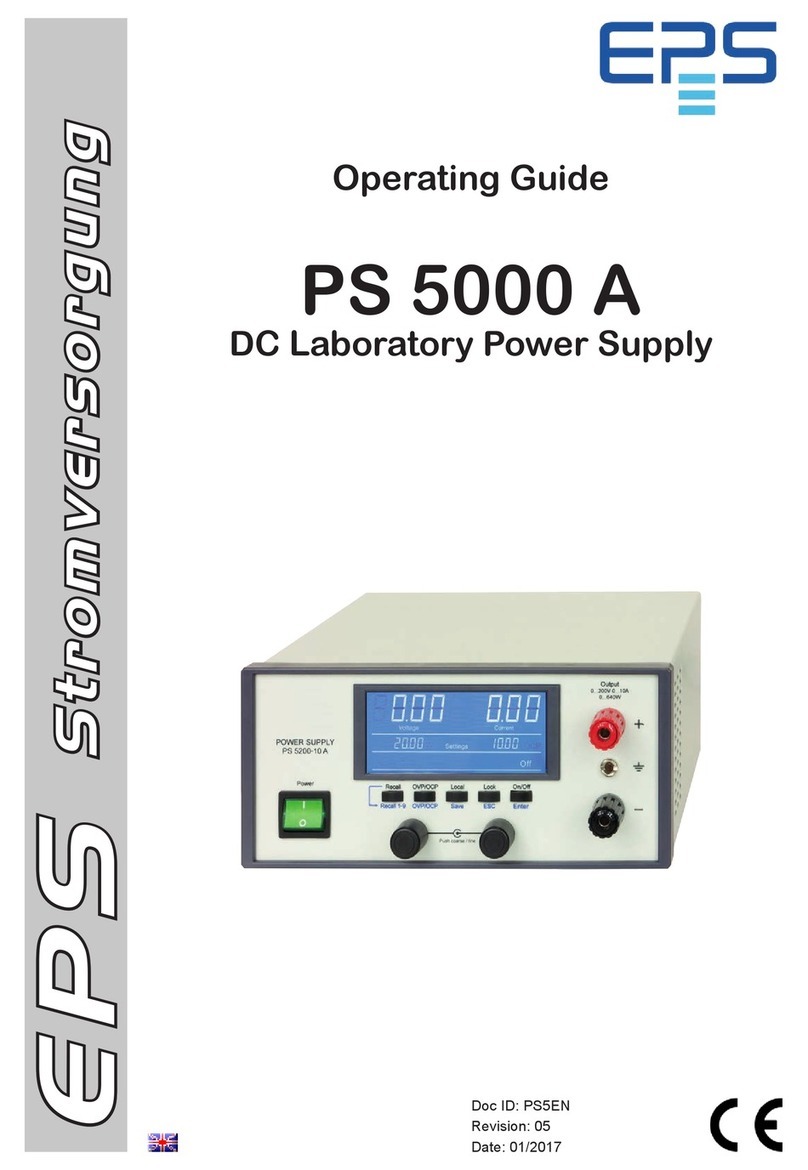
EPS Stromversorgung
EPS Stromversorgung PS 5040-10 A operating guide
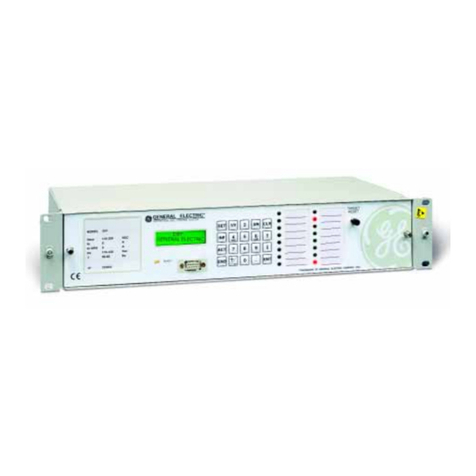
GE
GE K 106168E instructions

GE
GE LED 55 CC 1.4A TBDL 1-10V installation guide
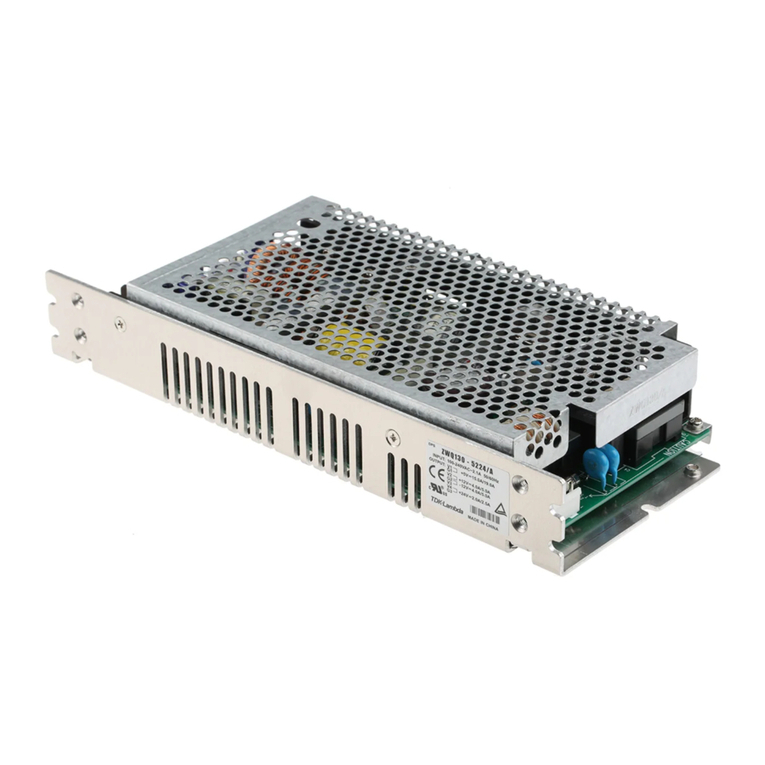
TDK-Lambda
TDK-Lambda ZWQ Series instruction manual
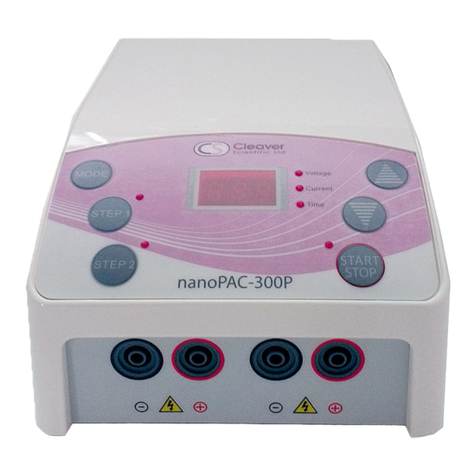
Roth
Roth MINI Instructions for use
